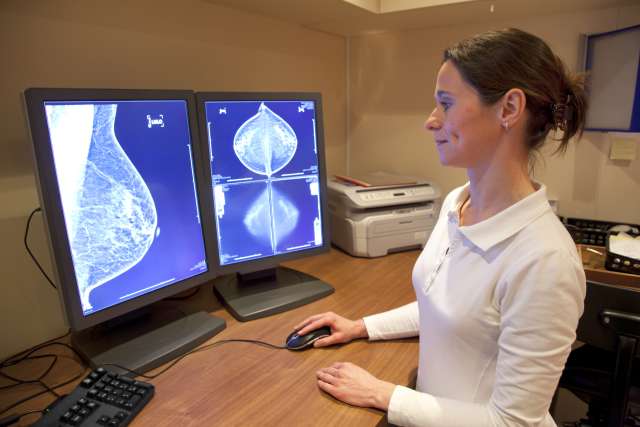If you or a loved one has recently been diagnosed with breast cancer, you are likely overwhelmed by this news. You might also be confused by the specifics of your diagnosis, which is probably chock-full of medical jargon, and might sound or read something like this: “L IDC, grade 1, ER+ PR+ HER2-, pT2N0M0 stage I disease.”
The following glossary of terms will help you decipher what it all means:
L or R: The “L” or “R” stands for left or right, indicating in which breast the cancer is located.
IDC or ILC: Breast cancer starts when a specific type of breast tissue cell goes awry and becomes cancerous. Naming where the breast cancer started is known as histology. IDC and ILC refer to the two most common histologies, or breast cell subtypes.
The “I” in both stands for invasive or infiltrating, which means that the breast cancer has spread from a single cell into surrounding breast tissue.
The second letter refers to where the cancer originated.
- Infiltrating ductal carcinoma (IDC) means that the cancer started in cells that line the breast’s milk ducts. This is the most common type of breast cancer, representing 76% of breast cancer cases.
- Invasive lobular carcinoma (ILC) means that the cancer started in the milk-producing glands, called lobules. This is the second most common histologic subtype, representing 8% of breast cancer cases.
The histology matters because it helps doctors predict how someone’s breast cancer will behave. It sometimes affects treatment decisions.
Other types of breast cancer histologies include ductal/lobular, mucinous, tubular, medullary, papillary, metaplastic and invasive micropapillary. All of these types refer to where the breast cancer formed.
Grade: A grade is assigned by a pathologist to each breast cancer case based on how the tumor cells appear under a microscope. The cancer’s grade often correlates to how aggressively the cancer cells are behaving: The higher the grade, the more the cancer cells are trying to rapidly grow and spread.
- Grade 1 means that the cells are well-differentiated, meaning they look like normal cells. In this case, their appearance is similar to normal breast tissue, and they are growing and spreading slowly.
- Grade 2 means that the cells are moderately differentiated. The cancer cells are growing somewhat more quickly.
- Grade 3 means that the cells are poorly differentiated. These cells look very different from normal breast cells and will grow and spread more quickly than the other types.
ER, PR and HER2: The terms ER, PR and HER2 refer to what’s known as the receptor status of your cancer. Receptors are proteins that lie in or on cells. In breast cancer, receptors on the breast cancer cells can attach to hormones to fuel their growth and spread.
- ER refers to “estrogen receptor.”
- PR refers to “progesterone receptor.”
- HER2 refers to “human epidermal growth factor receptor 2.”
With breast cancer, each of these hormone receptors is labeled for positive (+) or negative (-) to indicate whether that particular receptor is found on your cancer.
- Cancers that are “triple positive” are those with positivity of all three receptors.
- “Triple negative” cancers do not express any of these receptors and require different treatment types.
About 70% to 80% of breast cancers are hormone receptor-positive, and are sometimes labeled HR+ in place of ER+PR+. About 15% of breast cancers are HER2 positive.
The receptors on your cancer help dictate your stage and your treatment. If your cancer has estrogen receptors with or without progesterone receptors, you will be offered drugs that affect your body’s hormone levels. If your cancer has an abundance of HER2 receptors, you will be offered drugs that specifically target the HER2 receptor.
TNM: The term TNM stands for “tumor,” “node” and “metastasis.” This indicates the size of your tumor, the number of lymph nodes involved, and whether your cancer has metastasized, or spread.
Numbers are assigned to each category. For example, “T2” indicates that your tumor measures between 2 and 5 centimeters, and “N0” means your cancer has not spread to any lymph nodes. This is often referred to as the “TNM stage”
Stage: The stage of your breast cancer takes into account all of the previous factors, and is a quick way to indicate whether your breast cancer has spread, and if so, how far. Breast cancer is staged between 0 and 4. The lower the stage, the better your prognosis. Stage 4 indicates metastatic disease that has spread from the breast to other areas of your body.
P or C: The “p” or “c” in your cancer diagnosis indicates whether the breast cancer stage was assigned before or after surgery.
- P stands for pathologic, which means the breast cancer was staged after surgery by a pathologist in a lab who looked at your tumor under the microscope.
- C stands for clinical, which means that your physicians clinically staged your disease based on your breast exam and imaging.
Often, the pathologic stage is more accurate. The “p” or “c” goes before the TNM information in the cancer diagnosis.
Let’s revisit that diagnosis
If we look back to the breast cancer diagnosis at the top, let’s use what we learned to decode it: “L IDC, grade 1, ER+ PR+ HER2-, pT2N0M0 stage I disease.”
This breast cancer is in the left breast, and it started in the cells lining the milk ducts. It is grade 1, which means the cells are well-differentiated and appear under the microscope as similar to normal breast tissue. It is hormone receptor-positive for estrogen and progesterone, and is negative for HER2. The tumor measures between 2 and 5 centimeters. It has not spread to surrounding lymph nodes and has not metastasized, or spread to other areas of the body. It is considered stage 1, which means there is a good prognosis for treatment and recovery.
Medical jargon can be overwhelming, but it’s important to remember that your doctors and your extended team of care providers are dedicated to helping you through this. You do not have to “crack the code” of your cancer diagnosis alone.
Just as you are unique, so is your breast cancer. These medical terms help us better understand your unique cancer so that we can provide you with the most effective therapies, specifically tailored to you and your disease.
For more information on the UCLA Health breast health program, go to uclahealth.org/breasthealth.
Erin Chamberlain, MD, is a medical oncologist with the UCLA Health San Luis Obispo office.




